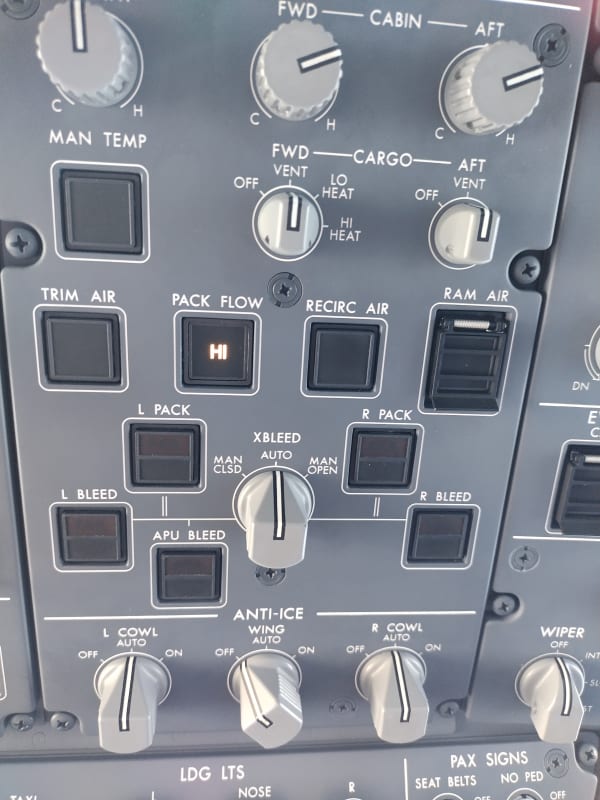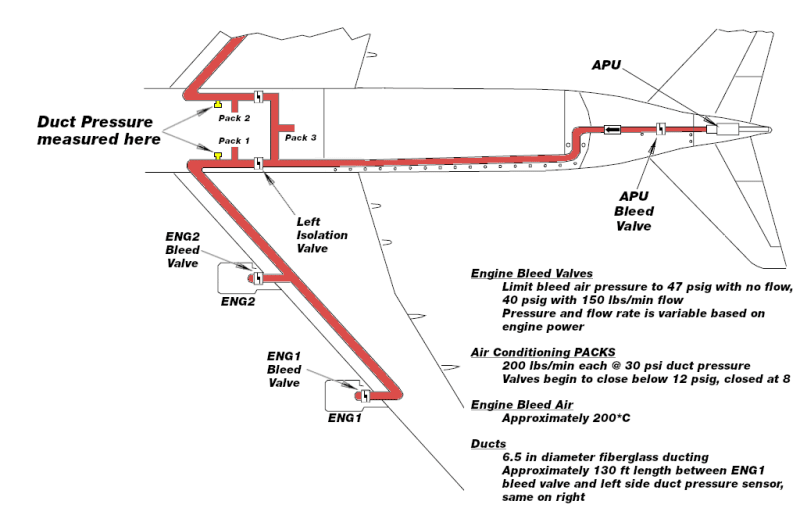This was originally posted at the engineering stack exchange.
I am currently modeling a high fidelity simulation of the Boeing 747-200 for a flight simulator, and I am now at the stage of programming what is essentially the HVAC system for the aircraft.
I will try to keep aviation jargon out of this unless it is necessary, for simplicity's sake.
Here is what I know about the system:
The aircraft has four engines, each of which can supply compressed air to the main air conditioning supply duct. The pressure (in PSI) of the air in the duct is directly output to a gauge on the flight engineer panel, and it is this gauge output that I am ultimately wanting to arrive at.
The compressed air from each engine is controlled via a regulator valve to a maximum of 47 psi with no flow, and 40 psi with 150 lbs/min flow (which seems to be the design maximum flow for each engine but I am not sure of this). With all four engines running, the theoretical supply is thus ~600 lbs/min.
There are 3 air conditioning units (PACKS in aviation terms) that are connected to this air conditioning supply duct, each can be turned off or on individually.
These air conditioning units are controlled semi-automatically, and require a minimum of 8 PSI in the duct to run (the poppet will force the valve to close if the duct pressure is less than 8 PSI). The valve also controls the mass flow rate into the air conditioning unit: according to my manuals, the AC Pack valve is fully open above 12 PSI until duct pressure exceeds ~30 PSI, and each pack attempts to regulate mass flow to approximately 200 lbs/min.
The ducting between the engines and the point at which the pressure is measured as well as where the AC packs are supplied is 6.5 inches in diameter and made of fiberglass. The air supplied by engines is routed through a pre-cooler in the engine itself that cools the air to approximately 175C, and this is approximately the temperature of the air at the point where pressure is being measured. The duct has a design leakage rate of about 300 SCFM at 45 PSI.
What I would like to calculate is the duct pressure, as it would be indicated on the flight engineer's gauge, based upon the inputs and outputs of the system. The gauge measures the pressure of the air just before entering the air conditioning manifold system (temperatures and pressures as mentioned above). What formula or set of formulas can I use to determine what the pressure in the duct is at any given moment based upon the input and the output of the system?
Thanks! Chris
I am currently modeling a high fidelity simulation of the Boeing 747-200 for a flight simulator, and I am now at the stage of programming what is essentially the HVAC system for the aircraft.
I will try to keep aviation jargon out of this unless it is necessary, for simplicity's sake.
Here is what I know about the system:
The aircraft has four engines, each of which can supply compressed air to the main air conditioning supply duct. The pressure (in PSI) of the air in the duct is directly output to a gauge on the flight engineer panel, and it is this gauge output that I am ultimately wanting to arrive at.
The compressed air from each engine is controlled via a regulator valve to a maximum of 47 psi with no flow, and 40 psi with 150 lbs/min flow (which seems to be the design maximum flow for each engine but I am not sure of this). With all four engines running, the theoretical supply is thus ~600 lbs/min.
There are 3 air conditioning units (PACKS in aviation terms) that are connected to this air conditioning supply duct, each can be turned off or on individually.
These air conditioning units are controlled semi-automatically, and require a minimum of 8 PSI in the duct to run (the poppet will force the valve to close if the duct pressure is less than 8 PSI). The valve also controls the mass flow rate into the air conditioning unit: according to my manuals, the AC Pack valve is fully open above 12 PSI until duct pressure exceeds ~30 PSI, and each pack attempts to regulate mass flow to approximately 200 lbs/min.
The ducting between the engines and the point at which the pressure is measured as well as where the AC packs are supplied is 6.5 inches in diameter and made of fiberglass. The air supplied by engines is routed through a pre-cooler in the engine itself that cools the air to approximately 175C, and this is approximately the temperature of the air at the point where pressure is being measured. The duct has a design leakage rate of about 300 SCFM at 45 PSI.
What I would like to calculate is the duct pressure, as it would be indicated on the flight engineer's gauge, based upon the inputs and outputs of the system. The gauge measures the pressure of the air just before entering the air conditioning manifold system (temperatures and pressures as mentioned above). What formula or set of formulas can I use to determine what the pressure in the duct is at any given moment based upon the input and the output of the system?
Thanks! Chris

![[smile] [smile] [smile]](/data/assets/smilies/smile.gif)


